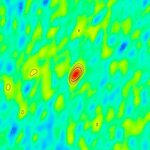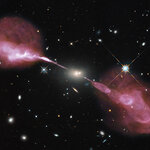Space

A miniature extraterrestrial version of Africa's Nile River Valley has been spotted on Saturn’s moon Titan - it stretches more than 400 km from its "headwaters" to a large sea.
Have you ever before seen such a large river system in high resolution outside Earth? No, you have not.
Scientists deduce that the river is filled with liquid because it appears dark along its entire extent in the high-resolution radar image, indicating a smooth surface.
Titan is the only other world we know of that has stable liquid on its surface. While Earth’s hydrologic cycle relies on…

In January of 2012, a new X-ray source flared and rapidly brightened in the Andromeda galaxy (M31), l2.5 million light-years from earth. The event was classified as an ultraluminous X-ray source (ULX), the second ever seen in M31 and efforts with X-ray telescopes and radio observatories resulted in the first detection of radio-emitting jets from a stellar-mass black hole outside our own galaxy.
A ULX is thought to be a binary system containing a black hole that is rapidly accreting gas from its stellar companion. To account for the high-energy output, gas must be flowing into the black hole…

Vega is a summer star in the Northern Hemisphere, visible toward the west at sunset. Vega is the brightest star in the constellation Lyra and, at only 25 light years away, quite close, cosmically speaking.
Due to its brightness, Vega has been used by astronomers as a touchstone to measure other stars' brightness for thousands of years - new findings say it may be more than 200 million years older than previously thought. The new estimation of Vega's age was made by more precisely measuring its spin speed with a tool called the Michigan Infrared Combiner, developed by John Monnier,…

In the constellation Taurus, astronomers have found the youngest still-forming solar system yet seen - an infant star called L1527 IRS, surrounded by a swirling disk of dust and gas 450 light-years from Earth.
The star only has about one-fifth the mass of the Sun, but will likely pull in material from its surroundings and eventually match the Sun's mass. The disk surrounding the young star contains at least enough mass to make seven Jupiters, the largest planet in our Solar System.
The nascent solar system is no more than 300,000 years old, compared to the 4.6-billion-year age of our…

The universe has always had some trace of heavy elements, such as carbon and oxygen, for as far back as astronomers could 'see'. These elements, originally churned from the explosion of massive stars, formed the building blocks for planetary bodies and eventually for life on Earth.
No more, say researchers who analyzed light from the most distant known quasar, ULASJ112010641, a galactic nucleus more than 13 billion light-years from Earth, and found matter with no discernible trace of heavy elements.
These quasar observations provide a snapshot of our universe during its…

The combined power of ESA's Herschel space observatory and the ground-based Keck telescopes mean hundreds of previously unseen starburst galaxies have been characterized, revealing extraordinary high star-formation rates across the history of the Universe. Starburst galaxies give birth to hundreds of solar masses' worth of stars each year in short-lived but intense events. By comparison, our own Milky Way Galaxy produces the equivalent of only one Sun-like star per year, on average.
Starburst galaxies generate so much starlight that they should outshine our Galaxy hundreds to thousands of…

A new analysis of topographic and gravity data from Titan, the largest moon orbiting Saturn, indicates its icy outer crust is twice as thick as has generally been thought.
Is there a vast ocean of liquid water lies under the crust?. The new study suggests that the internally generated heat that keeps that ocean from freezing solid depends far more on Titan's interactions with Saturn and its other moons than had been suspected.
Howard Zebker, a professor of geophysics and of electrical engineering at Stanford University, present the findings at theAmerican Geophysical Union (AGU) in San…

Astronomers find planets in strange places and wonder if they might support life. One such place would be in orbit around a white or brown dwarf. While neither is a star like the sun, both glow and so could be orbited by planets with the right ingredients for life.
No terrestrial, or Earth-like planets have yet been confirmed orbiting white or brown dwarfs, but there is no reason to assume they don't exist. However, new research by Rory Barnes of the University of Washington and René Heller of Germany's Leibniz Institute for Astrophysics Potsdam hints that planets orbiting white or brown…

Spectacular jets powered by the gravitational energy of a super massive black hole in the core of the elliptical galaxy Hercules A are shown off by the combined imaging power of the Hubble Space Telescope's Wide Field Camera 3 and the recently upgraded Karl G. Jansky Very Large Array (VLA) radio telescope in New Mexico.
Hercules A is about 2 billion light-years away, is roughly 1,000 times more massive than the Milky Way and harbors a 2.5-billion-solar-mass central black hole that is 1,000 times more massive than the black hole in the Milky Way.But the yellowish elliptical galaxy in the…

Astronomers theorize that an as-yet-unidentified form of matter is responsible for 90 percent of the gravity within galaxies and clusters of galaxies but because it is detected via its gravity and not its light, they call it "dark matter."
Astronomers announced earlier this year that Hubble's Wide Field Planetary Camera 2 imaging suggested that a clump of dark matter was left behind during a clash between massive galaxies clusters in Abell 520, located 2.4 billion light-years from Earth. This dark matter must have collected into a "dark core" that contained far fewer…